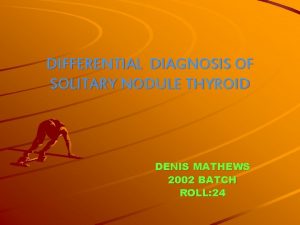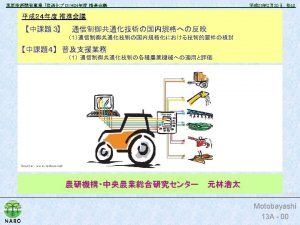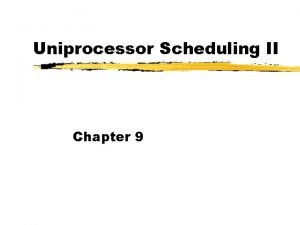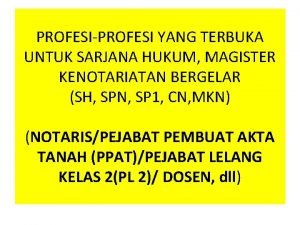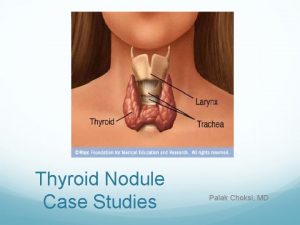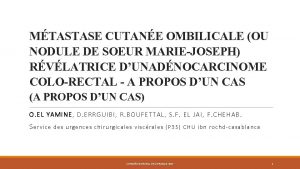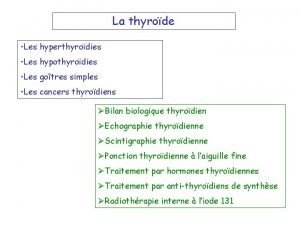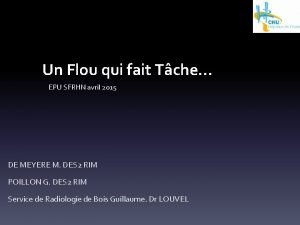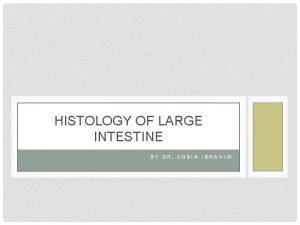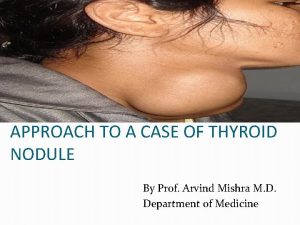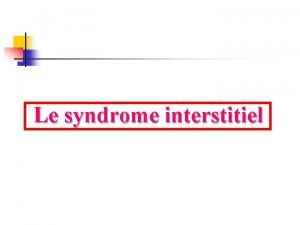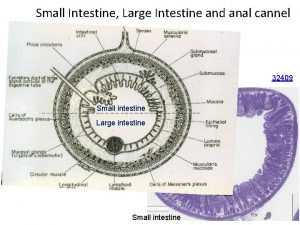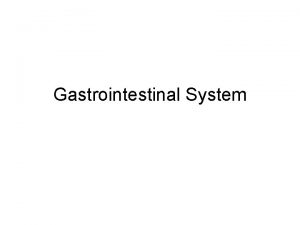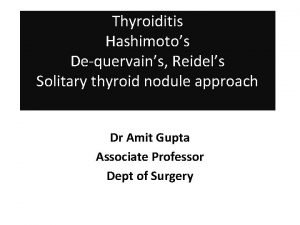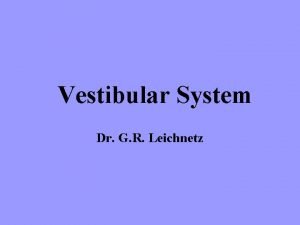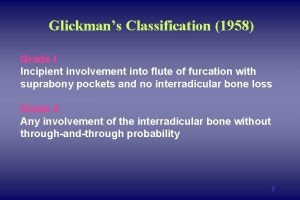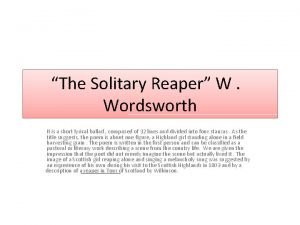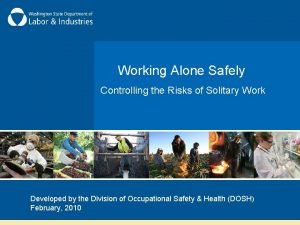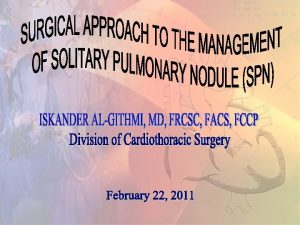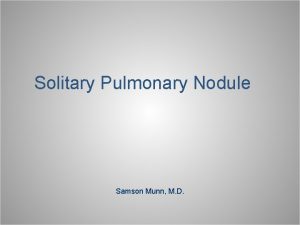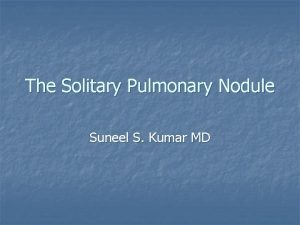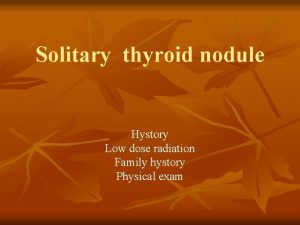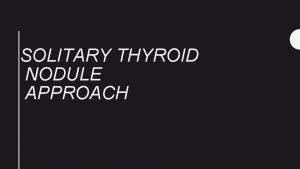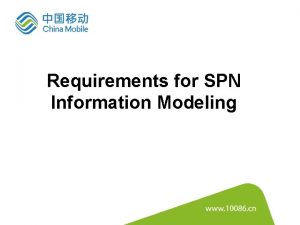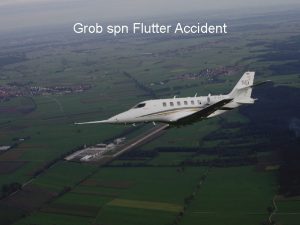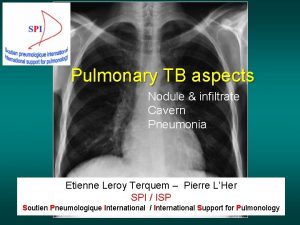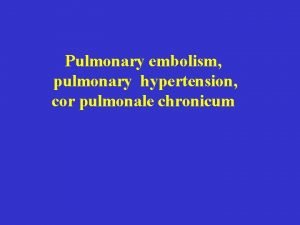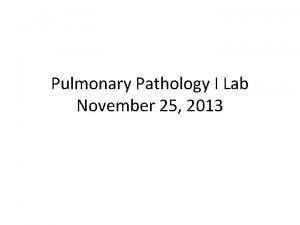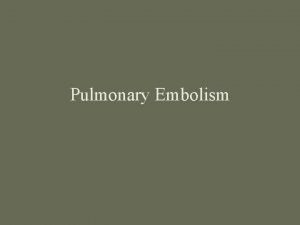Solitary Pulmonary Nodule SOLITARY PULMONARY NODULE SPN On






























- Slides: 30


Solitary Pulmonary Nodule

SOLITARY PULMONARY NODULE SPN On Chest Radiography would raise several questions Is the nodule benign or malignant? Should it be investigated or observed? Should it be surgically resected?

SOLITARY PULMONARY NODULE Definition : Single, round and discrete pulmonary opacity that measure <3 cm. in diameter, surrounded by normal lung tissue and not associated with adenopathy or atelectasis. ~ 150, 000 solitary pulmonary nodule (or coin lesions) are detected annually in the US and often discovered incidentally at Cx. R or CT or 1 -2 SPNs per 500 Cx. R

SOLITARY PULMONARY NODULE Major question benign or malignant. Although most solitary pulmonary nodules have benign cause, “healed granuloma” (TB or fungi), 30 -40% of these nodules are malignant (range 3 -80%) More recent studies generally show higher percentage of malignancy among resected nodules than do older studies, presumably related to improved diagnostic techniques (CT, PET)

SOLITARY PULMONARY NODULE Malignant causes of Solitary Pulmonary Nodules Primary Lesions Metastatic Lesions Adeno CA Squamous Cell CA Large Cell CA Breast Head and Neck Melanoma Small Cell CA Lymphoma Carcinoid Colon Kidney Sarcoma

Solitary Pulmonary Nodule • “ Remember that exploratory incision should not be made a cloak for diagnostic incompetence” – Rutherford Morrison (1853 -1939)

SOLITARY PULMONARY NODULE Factors affecting the likelihood of malignancy Age History of Smoking Presence of other malignancy Size of lesion Border characteristic of lesion Calcification of Lesion Growth rate of lesion

SOLITARY PULMONARY NODULE Patient Age The probability of a SPN being malignant rises with increasing patient age. A study of malignancy in 955 patients in 1983: - 65% > 50 y/o - 35% < 50 y/o But have to be cautious in assuming that a SPN in a young person is benign.

SOLITARY PULMONARY NODULE Underlying Risk Factors History of smoking – strong association cigarette smoking with primary lung CA of Previously diagnosed malignancy increases the likelihood that SPN may represent metastatic disease. ~ 10 -30% of resected nodules are metastatic malignancies. malignant pulmonary from extrathoracic

SOLITARY PULMONARY NODULE Size of the Lesion : - Small lesions tend to be benign - In fact, 25 -35% of SPN under 1 cm have been shown to be malignant - Over 80% of lesion > 5 cm. are malignant

SOLITARY PULMONARY NODULE Growth Rate : - A nodule that is stable for 2 years is almost always benign. - Doubling time – a 25% increase in diameter - Most malignancy doubling time: 30 -465 days. - Some like osteosarcoma or germ cell tumor can double faster.

SOLITARY PULMONARY NODULE Calcification : - Calcium are present in > 50% of benign nodules. - Benign calcification appears central or diffuse pattern. as laminated - Calcium may present in 15% of malignant nodule, but usually eccentrically located.

SOLITARY PULMONARY NODULE Diagnostic tools for evaluation of lung nodules: X-ray or CT scan Bronchoscopy (including direct biopsy, needle biopsy and brushing and washing for cytology) Percutaneous fine needle aspiration biopsy. PET/CT Scan Excisional Biopsy - Video assisted - Thoracotomy

SOLITARY PULMONARY NODULE Percutaneous Needle Biopsy (PNB) - Reliable with reported sensitivity 64 -97% for diagnosis malignancy. - In benign disease, between 50 -80%. the accuracy varies - Relatively Safe with Pneumothorex complication rate 30% and 5 -10% requiring chest tube drainage. - There is no doubt that PNB reduce the number of patients require thoracotomy.

SOLITARY PULMONARY NODULE PET/CT Scan - The sensitivity of PET for diagnosing lung cancer approaches 95% with a specificity of over 85%. - One study has demonstrated that for SPNs, a negative PET scan associated with only a 4. 7% risk of malignancy. - False-negative PET scan are usually associated with lesions < 1 cm. in size & in BAC.

Tissue characterization of SPN: Comparative study between helical CT and integrated PET/CT • Methods: 119 Pt. with SPN-underwent both enhanced spiral CT and PET/CT scan • On spiral CT, a nodule was considered malignant with enhancement of >25 HU • On PET/CT, nodules were considered malignant with Max. SUV >3. 5 The sensitivity, specificity and accuracy were compared

Results: There were 79 malignant & 40 benign nodule Sensitivity, specificity and accuracy of enhanced CT were 81%, 93% & 85% Those on PET/CT were 96% e p=0. 008, 88% e p=0. 72 & accuracy 93% e p=0. 011 Conclusion: PET/CT may be performed as 1 st line test for SPN JNM 2006; 47(3)443 -

SOLITARY PULMONARY NODULE Video-Assisted thoracic excisional biopsy - Safe and highly effective in diagnosing and often in treating solitary pulmonary nodule. - But smaller lesion may be difficult to localize. - Series from the Brigham and Women’s Hospital reported successful resection of lesions < 1 cm in diameter without any localization techniques. (N Engl J Med 1995, 52: 515)

SOLITARY PULMONARY NODULE Who makes surgical decision? Important decisions made by physician and by patient himself. patient’s Often patient decides between follow-up or surgery

SOLITARY PULMONARY NODULE Decision may be influenced by numerous factors including the probability that the nodule is malignant, risks of surgery, accuracy of biopsy technique and fear that delay in surgical resection may forfeit the possibility of cure. In addition, surgeon confidence and experience are important in decision making.

SOLITARY PULMONARY NODULE The management options : include - “wait and watch” strategy or - Immediate surgery - Biopsy of the nodule based on which decision is taken.

Solitary Pulmonary Nodule “Action is not a substitute for judgment”

SOLITARY PULMONARY NODULE Wait and watch strategy - There are no studies demonstrating a decrease in survival when patient is kept under observation for few months to assess the growth of the nodule. - Observation is advisable when the risk of malignancy is low, the risk of surgery is high or the patient refused further invasive procedures.

SOLITARY PULMONARY NODULE - The proponents of immediate surgery argue that if surgery is delayed, it allows time for the growth of the nodule and therapy reduce the chance of a 5 year survival. - Cummings et. al. (proposed the use of decision analysis based on the probability that the nodule is malignant using Bayes Theorem and four variables I. e. age, history of smoking, diameter of the nodule and prevalence of malignancy. The average of life expectancy in years of various strategies was then compared.

SOLITARY PULMONARY NODULE Decision In patients with calculated probability of malignancy greater than 75 -80%, early surgery appeared slightly superior to the needle biopsy. In patients with probability of malignancy less than 75 -80%, needle biopsy was slightly superior to immediate surgery. Observation was suggested when the likelihood of malignancy was <5% or the risk of surgery was high. (Am Rev Respir Dis 1988; 134(3)453)

SOLITARY PULMONARY NODULE New nodule identified on standard CT scanning Benign calcification pattern on CT or stability for 2 yr. on arcival films Risk factors for surgery • Predicted postoperative FEV 1 < 0. 8 liter • VO 2 max < 10 -15 ml/kg/min Ye s No further testing No Does probability of cancer warrant surgery, given the Surgical risk? Ye s No Low probability of cancer (<10%) Serial high-resolution CT at 3, 6, 9, 12, 18 and 24 mo. Moderate probability of cancer (10 -60%) Negati ve tests Additional testing • PET if nodule >1 cm in diameter • Contrast-enhanced CT, depending on institutional expertise • Transthoracic fine-needle aspiration biopsy if nodule is peripherally located * Bronchoscopy if air-bronchus sign present Postive tsts Video-assisted thoracoscopic Surgery, examination of a Frozen section, followed by Lobectomy if nodule is malignant Approach to the Management of Solitary Pulmonary Nodules

SOLITARY PULMONARY NODULE Conclusions: There is no one way to manage the indeterminate nodule, but the diagnosis require a suitable clinical evaluation. The judicious application of diagnostic methods that based on the medicine evidence based, will improve the quality of the medical attention. Excisional biopsy may be attractive for the surgeon because it provides a definite diagnosis and place the surgeon in a win position.

SOLITARY PULMONARY NODULE Conclusions: It is important to assess and respect the patient’s anxiety and fears. Most importantly, surgeons must personally oversee the follow-up and be willing to change their opinion, as new evidence is available. It is my bias that these nodules are best managed by thoracic surgeons who must have confidence that the algorithm followed in observing some patients, will not alter the ultimate outcome, even if the nodule should subsequently prove malignant.

THANK YOU!
 Thyroid isotope scan
Thyroid isotope scan Spn pgn
Spn pgn Shortest process next (spn)
Shortest process next (spn) S.pn sarjana apa
S.pn sarjana apa Golden ticket active directory
Golden ticket active directory El subjuntivo se usar para expresar ________.
El subjuntivo se usar para expresar ________. Semmelweis
Semmelweis Nodule isoéchogène tirads 3
Nodule isoéchogène tirads 3 Palak choksi
Palak choksi Criteres de jones
Criteres de jones Nodule de sœur marie-joseph scanner
Nodule de sœur marie-joseph scanner Low-set ears vs normal
Low-set ears vs normal Enlever nodule thyroide
Enlever nodule thyroide Lepidique
Lepidique Rectum
Rectum Hot thyroid nodule
Hot thyroid nodule Syndrome interstitiel diffus
Syndrome interstitiel diffus Muscularis mucosa
Muscularis mucosa Stomach
Stomach Riedel's thyroiditis
Riedel's thyroiditis Flocculonodular
Flocculonodular Furcation classification glickman
Furcation classification glickman Hallermann-streiff-syndrom bilder
Hallermann-streiff-syndrom bilder Solitary independent play
Solitary independent play Arrangement of flower on floral axis
Arrangement of flower on floral axis Solitary hotel barber
Solitary hotel barber Solitary as an oyster pee paragraph
Solitary as an oyster pee paragraph Who has composed the poem the solitary reaper
Who has composed the poem the solitary reaper Solitary as an oyster pee paragraph
Solitary as an oyster pee paragraph Solitary
Solitary Ccohs working alone
Ccohs working alone
